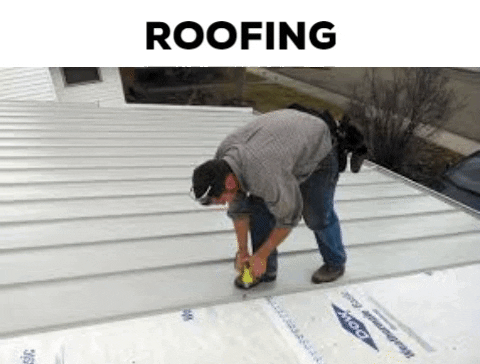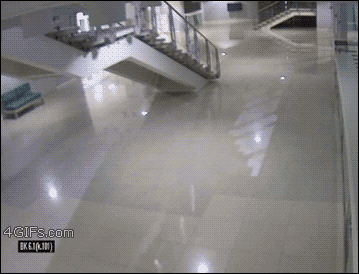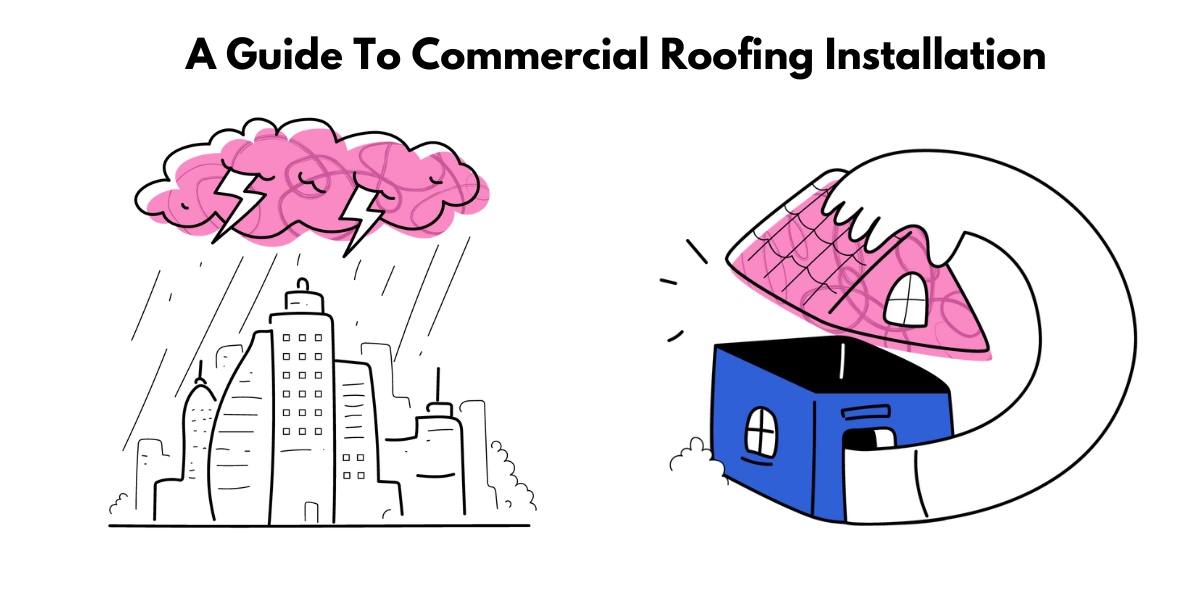How to Install Commercial Roofing: Guide to Commercial Flat Roofing
What is commercial roofing?
Commercial roofing is a crucial aspect of any building’s construction, as it provides shelter and protection from the elements. It is essential to choose the right type of roofing material based on your building’s needs, location, and weather conditions. Commercial roofing materials can be classified based on their composition, installation process, and durability. Some of the most commonly used commercial roofing materials include single-ply (TPO, PVC, EPDM), concrete, modified bitumen, built-up roofing systems, tar and gravel, and metal roofing. Each material has its own advantages and disadvantages, such as durability, cost, and ease of installation. For example, PVC roofs are a preferred choice for commercial flat roofs, while metal roofing is suitable for buildings with a roof slope greater than two inches. Ultimately, choosing the right commercial roofing material is crucial for ensuring the longevity and efficiency of your building’s roof and protecting your investment.
What to consider when installing commercial roofing
1. Type of Roofing System
Commercial buildings require a roofing system that is both efficient and economical in maintaining the watertight integrity of the structure and keeping its contents dry. Choosing the right type of roofing system is crucial in ensuring the safety and longevity of the building. There are several types of roofing systems available for commercial buildings, including Built-Up Roofing (BUR), Modified Bitumen Roofing (MBR), Single-Ply Roofing (SPR), and Metal Roofing.
- Built-Up Roofing (BUR) is the most traditional type of roofing system and has been in use in the US for over 100 years. This roofing system is commonly referred to as “tar and/or gravel” roofs. BUR consists of multiple layers of bitumen and reinforcing fabrics that create a durable and long-lasting roof. It is ideal for buildings that experience high foot traffic or require a more heavy-duty roofing system.
- Modified Bitumen Roofing (MBR) is a type of roofing system that is made up of polymer-modified bitumen or modified bitumen sheet membranes. It was developed in Europe in the early 1960s and has been in use in the US. MBR is a durable and flexible roofing system that is resistant to punctures and tears. It is ideal for buildings that experience extreme weather conditions or have high foot traffic.
- Single-Ply Roofing (SPR) is a roofing system that is made up of a single layer of roofing material. There are three types of SPR: Thermoplastic Olefin (TPO), Polyvinyl Chloride (PVC), and Ethylene Propylene Diene Monomer (EPDM). TPO and PVC are thermoplastic materials that are distinguished from thermoset materials in that there is no chemical crosslinking. EPDM is a synthetic rubber material that is highly durable and resistant to weathering and UV radiation. SPR is ideal for buildings that require a lightweight and energy-efficient roofing system.
- Metal Roofing is a roofing system that is made up of metal panels or shingles. It is a durable and long-lasting roofing system that is resistant to weathering and UV radiation. Metal roofing is ideal for buildings that require a low-maintenance roofing system that can withstand extreme weather conditions.

2. Installer Qualifications
It is crucial to hire a qualified installer for commercial roofing projects to ensure that the work is done properly and safely. Here are the qualifications that an installer should possess, listed in order of importance: First, the installer should have proper certifications and licenses to perform the work legally and guarantee their expertise in the field. Second, they should have a significant amount of experience in commercial roofing, ideally with a portfolio of successful projects completed. Third, they should be able to provide references from previous clients to verify their quality of work. Hiring a qualified installer will ensure that the commercial roofing installation is done correctly and will last for years to come.
3. Cost of Installation
The total cost of commercial roofing services, including installation, inspection, and maintenance, depends on various factors such as the type of roof, accessibility, and slope, essential permits, scope of services, and additional features. To make an informed decision about the cost of installing commercial roofing, it is essential to consider these factors. By doing so, you can ensure that the installation is completed on time, within budget, and with the necessary resources.
4. Materials Used
Installing a commercial roofing system is a significant investment for any business. It is important to choose the right materials to ensure that the roof is durable, long-lasting, and able to withstand various weather conditions. There are several different types of materials available for commercial roofing, each with its own set of advantages and disadvantages. In this article, we will explore some of the most common materials used for commercial roofing and their characteristics.
Different Types of Commercial Roofing Materials:
- PVC: PVC (polyvinyl chloride) is a single-ply roofing membrane that is highly durable and resistant to UV rays. It is also fire-resistant and can last up to 30 years. However, PVC roofing can be expensive compared to other materials.
- TPO: TPO (thermoplastic olefin) is another popular single-ply roofing membrane. It is highly reflective, making it an energy-efficient option. TPO roofing is also resistant to punctures, tears, and UV rays. However, it can be prone to shrinkage over time.
- EPDM: EPDM (ethylene propylene diene terpolymer) is a synthetic rubber roofing membrane. It is highly durable, resistant to UV rays, and can last up to 50 years. However, EPDM roofing can be susceptible to punctures and tears, especially in areas with heavy foot traffic.
- Metal: Metal roofing is a durable and long-lasting option for commercial buildings. It is available in various materials such as aluminum, copper, and tin. Metal roofs are highly resistant to fire, wind, and hail damage. They are also energy-efficient and can last up to 50 years. However, metal roofing can be expensive compared to other materials.
- Asphalt Shingles: Asphalt shingles are a popular and cost-effective roofing option for commercial buildings. They are available in various colors and styles, making them a versatile choice. Asphalt shingles are also easy to install and repair. However, they are not as durable as other materials and can be prone to cracking and curling over time.

5. Warranty
When considering the installation of commercial roofing, it is important to pay close attention to warranties. Here are some key points to keep in mind:
- Look for products that are backed by a non-prorated warranty of at least 20-25 years.
- Make sure the warranty covers both materials and labor.
- Check that the company providing the warranty is fully insured and covered in all states where they work.
- Consider the reputation of the roofing systems and the company providing the warranty.
- Get everything in writing and ensure there are no hidden surprises at the end.
6. Experience of the Company
The success of your roofing project depends heavily on the expertise and skills of the contractor you hire. Here are a few factors to consider when evaluating a company’s experience:
- Years in Business: One of the first things to consider is the number of years the company has been in business. A company with a long history in the industry has likely encountered and overcome a wide range of roofing challenges. This experience can help them identify potential issues before they become major problems, saving time and money down the road.
- Size and Complexity of Past Projects: The size and complexity of past projects can also be a good indicator of a company’s experience. A contractor who has worked on large, complicated commercial roofing projects will have the knowledge and skills necessary to handle your project, no matter how challenging it may be.
- Qualifications of Employees: The qualifications of a company’s employees are also important to consider. Look for a contractor with a team of skilled, trained, and certified professionals. This will ensure that your roofing project is completed to the highest standards and that any issues are addressed promptly and effectively.
- Each of these factors can have a significant impact on the success of your commercial roofing project. A company with a long history in business, experience in handling complex projects, and a team of qualified professionals is more likely to deliver high-quality results. An inexperienced company may struggle to identify and resolve issues, leading to delays, additional costs, and subpar workmanship.
7. Safety Standards
In installing commercial roofing, safety should always be the top priority. Not only does it protect the workers, but it also ensures the safety of clients and the public below the worksites. In this section, we will discuss the necessary safety measures that must be followed during the installation process, in order to prevent accidents and injuries. Here is an ordered list of safety measures that must be followed during the installation process:
- Project Planning: Before starting any project, it is essential to develop a detailed plan that outlines the safety measures to be followed. This plan should be communicated to all workers and regularly reviewed to ensure that everyone is aware of the safety procedures.
- Jobsite Set-Up: The job site should be set up in a way that minimizes the risk of accidents and injuries. This includes ensuring that all equipment is properly maintained and inspected, that workers are provided with appropriate personal protective equipment (PPE), and that all safety signs and barriers are in place.
- Daily Operations: During the installation process, it is important to follow proper safety procedures. This includes ensuring that workers are trained to use equipment safely, that they are working in a safe environment, and that they are following all safety guidelines.

8. Performance of the Roof
Factors to consider when assessing the performance of the roof during installation:
- Durability: This is important because it reduces the need for frequent repairs and replacements, which can be costly. For instance, metal roofing is a durable option that can last for over 50 years with proper maintenance.
- Weather resistance: A roof that is able to withstand extreme weather conditions such as heavy rain, strong winds, and hailstones is ideal. This is important because it ensures that your building and its occupants are protected from the elements.
- Energy efficiency: This can help to reduce energy costs by keeping the building cool in the summer and warm in the winter. Moreover, it reduces the strain on HVAC systems and helps to lower energy bills.
- Ease of maintenance: Regular maintenance helps to prevent small issues from becoming major problems that can be expensive to fix. For example, modified bitumen roofs are easy to maintain and can be repaired quickly and efficiently.
9. Impact on the Building Structure
One of the most significant factors to consider is the weight of the roofing materials. It can vary depending on the type of roofing system selected for the project. For instance, a flat roof made of concrete will be much heavier than a flat roof made of a lighter material such as PVC. The weight of the roofing materials can put a significant amount of stress on the building’s structure, particularly the roof deck. To minimize the risk of damage, it may be necessary to reinforce the roof deck or install additional support beams.
Another factor to consider is the type of roofing system being installed. Some roofing systems require more support than others, which can impact the building’s structure differently. For example, a pitched roof may require additional support in the form of trusses or rafters, while a flat roof may require additional insulation to prevent moisture buildup. The condition of the building’s foundation is also a crucial factor to consider. A weak or compromised foundation can lead to structural damage during the installation process. Before beginning any roofing installation, it is important to conduct a thorough inspection of the building’s foundation to ensure that it is strong enough to support the new roofing system.
To minimize the risk of damage to the building’s structure, it is important to take necessary precautions during the installation process. This may include hiring a professional roofing contractor with experience in commercial roofing installations, ensuring that the roofing materials are properly stored and handled, and taking steps to protect the building’s interior from potential damage.
How to install commercial roofing using ballasted single-ply roofing system
Step 1: Decide on the type of roofing system you need
It is essential to select a system that not only provides protection from the elements but also meets the specific needs of the building. To help you make an informed decision, follow these steps:
- Evaluate the building size and shape to determine the appropriate roofing system. Flat roofs are efficient and economical for large buildings, while sloped roofs may be more suitable for smaller structures.
- Consider the climate and weather conditions in the area. Choose a roofing system that is durable and can withstand harsh weather conditions such as strong winds, heavy rain, and snow.
- Determine your budget for the roofing system. Evaluate the long-term costs of different materials and select a system that provides the best value for your investment.
- Research different roofing materials and their specific features and benefits. Consider factors such as longevity, energy efficiency, and ease of installation.
- Consult with a reliable roofing contractor to assess your building’s needs and recommend the most suitable roofing system.
Step 2: Get a permit
Obtaining a permit ensures that the installation will be done safely and legally. Here is an ordered list of steps on how to obtain a permit:
- Research local regulations and codes to determine what permits are required and what documents are needed for the permit application.
- Prepare and submit the necessary documents, which may include building plans, specifications, and engineering reports.
- Pay any required fees associated with the permit application.
- Wait for the permit to be approved before beginning the installation process.
Step 3: Consult with contractors and suppliers
The lack of qualified workers in the roofing industry makes it important to collaborate with contractors and suppliers to ensure a successful installation. Here are some actions to follow when consulting with contractors and suppliers:
- Clearly communicate project requirements, including timeline, budget, and materials needed.
- Discuss any potential challenges that may arise during the installation process and come up with solutions together.
- Obtain detailed quotes from suppliers and contractors to compare pricing and services.
- Confirm that the contractors and suppliers are licensed and insured.
Step 4: Build a budget and choose the right material for your needs
- Assess your roofing needs.
- Choose the right material.
- Consider the cost.
- Hire a reliable contractor.
- Plan for regular maintenance.

Step 5: Pre-installation preparations should be made
- The roofing contractor should conduct a thorough inspection of the roof to identify any existing problems that may affect the installation of the new roofing system.
- The roof surface should be cleaned and cleared of any debris, including dirt, leaves, and other materials that may interfere with the installation process.
- The roofing contractor should ensure that the roof is properly prepared for the installation of the ballasted single-ply roofing system.
- The roofing contractor should ensure that all necessary permits and approvals have been obtained before starting the installation process.
FAQs
What is commercial roofing?
Commercial roofing is an essential aspect of the construction industry, providing shelter and protection to commercial buildings and establishments. A commercial roof’s primary function is to protect the property from external elements, including weather, water, and other potential hazards. Commercial roofing materials vary depending on the building’s design, purpose, and location. The most common types of commercial roofing materials include single-ply (TPO, PVC, EPDM), concrete, modified bitumen, built-up roofing systems, tar and gravel, and metal roofing. Single-ply roofing materials are preferred for flat roofs, while metal roofing is ideal for sloped roofs. Concrete roofing is durable and long-lasting, while modified bitumen is ideal for low-sloped roofs. Each material has its advantages and disadvantages, making it essential to choose the right one for your building’s needs. The importance of professional installation cannot be overstated, as it ensures the roofing system’s durability and longevity. Choosing the right commercial roofing material and having it installed by a professional is crucial in maintaining a safe and secure commercial building.
What types of commercial roofing are available?
There are various types of commercial roofing available, each with its own unique features and benefits. Here are some of the most common types of commercial roofing:
- Pitched Roofs: These are sloping roofs that are commonly found on residential buildings, but can also be used on commercial buildings. They are made of materials like asphalt shingles, concrete tiles, and metal sheets.
- Flat Roofs: Flat roofs are a popular choice for commercial buildings. They are typically made of single-ply materials like PVC, TPO, and EPDM synthetic rubber. They are efficient and economical in design.
- Low-Sloped Roofs: These roofs have a slight slope and are commonly found on industrial buildings. They are made of materials like metal sheets, corrugated galvanized steel, stainless steel, and more.
- Metal Roofs: Metal roofs are a durable and fire-resistant option for commercial buildings. They are available in different materials like metal tile sheets, copper, and aggregates of aluminum, zinc, tin, and more.
- Commercial Coatings: Commercial roofing systems can also be restored or repaired using roof coatings. These coatings can be made of materials like acrylic and urethane-modified acrylic, and are used to protect against rusting and damage from environmental factors.

What are the benefits of metal roofing?
Metal roofing is a popular and durable option for commercial roofing installations. Here are some advantages of metal roofing for commercial buildings:
- Variety of materials and color choices for design options
- Ability to hold up to high winds and snow for stability
- Energy-efficient as sheet metal can be made from recycled material
- Fire-resistant and less prone to fire damage
- Can last up to 40 years with proper installation and maintenance
What should I look for when choosing a roofing contractor?
When choosing a roofing contractor, it can be overwhelming to know what to look for. Here are some important factors to consider to ensure you hire a reliable and experienced professional:
- Check for proper licensing and insurance. A reputable roofing contractor will have all the necessary licenses and insurance to protect you and your workers.
- Look for experience and expertise. A contractor with a proven track record and experience in the specific type of roofing you need is a good sign.
- Read reviews and ask for references. Checking reviews and asking for references from past clients can give you an idea of the quality of work and customer service provided.
- Get multiple quotes. Getting quotes from multiple contractors can help you compare pricing and find the best deal.
- Ask about warranties and guarantees. A good contractor will offer warranties and guarantees to ensure the quality of their work.
By keeping these factors in mind, you can make an informed decision and find a roofing contractor that will provide quality work and peace of mind.



